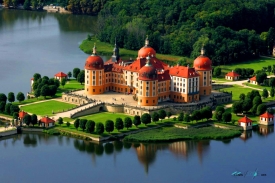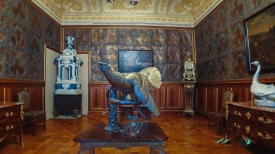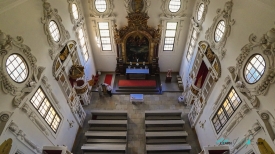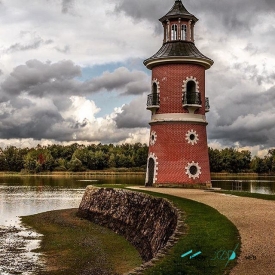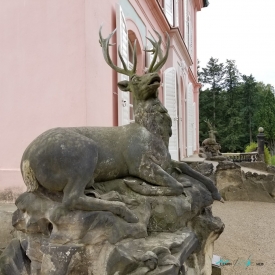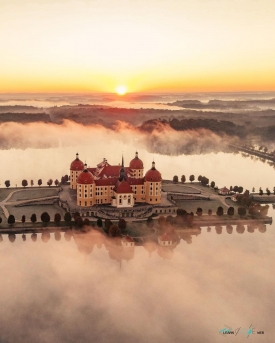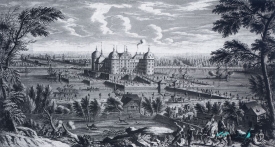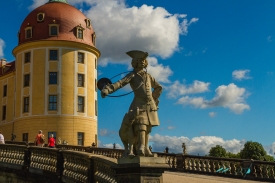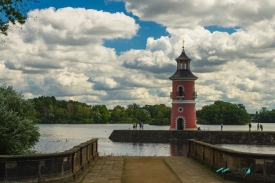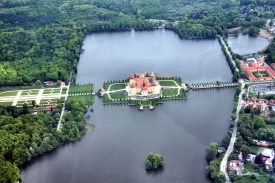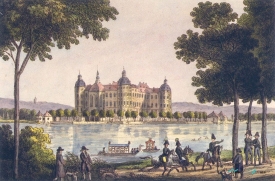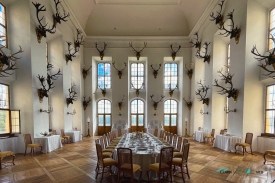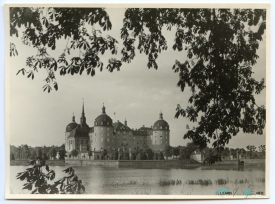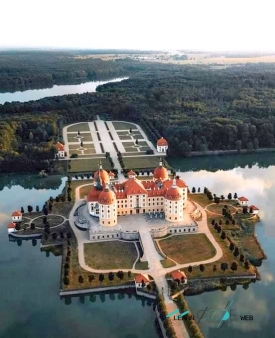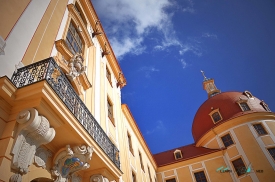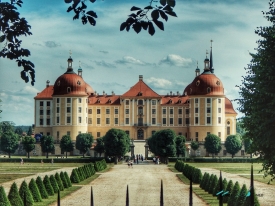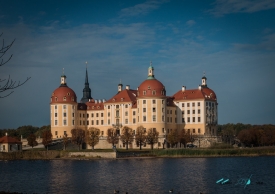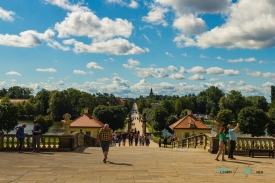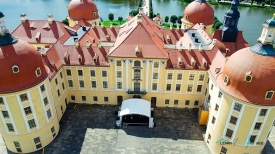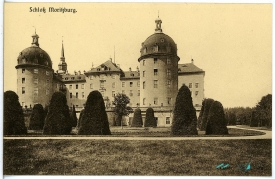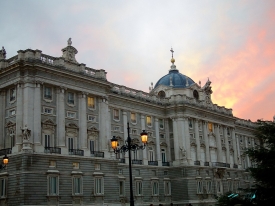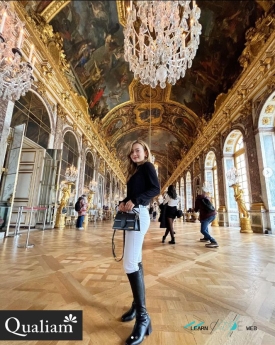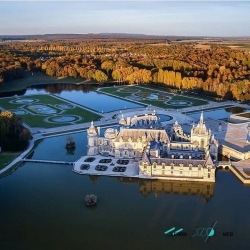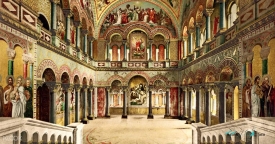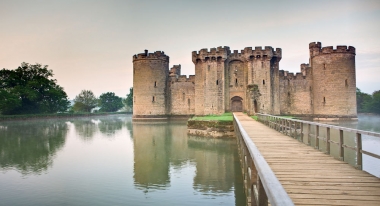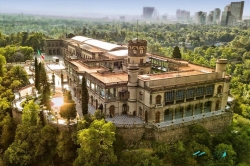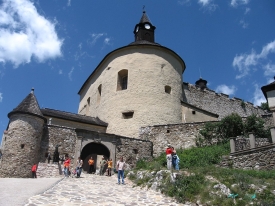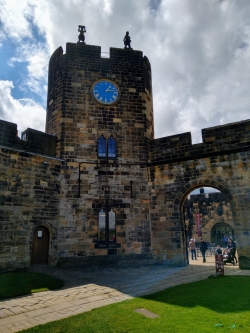ABOUT Moritzburg Castle
Moritzburg Castle or Schloss Moritzburg, named after Duke Moritz, is probably the most beautiful moated castle in Saxony. In 1542 he had a hunting lodge built near Dresden. From 1723 August the Strong rebuilt it under the direction of Matthäus Pöppelmann into a magnificent baroque palace in the middle of a spacious pond and park. One of the most important hunting trophy collections in Europe, artistic gold leather wallpaper and the "feather room" decorated with over a million colored bird feathers are just a few of the treasures that Moritzburg Castle houses. Winter is like a fairy tale in the truest sense of the word: every year, Moritzburg Castle is transformed into the enchanting backdrop of the legendary fairy tale film »Three Hazelnuts for Cinderella«. Fans then walk in the footsteps of the cheeky princess at the original film location.
In 1542, Duke Moritz of Saxony had a Renaissance-style hunting lodge built on a granite hilltop in Friedewald, which is rich in game. This castle, which was later given the name of the duke, soon became the center of the Saxon hunting party. The palace chapel was not built until 1661 under the direction of Elector Johann Georg II and was consecrated as a Catholic in the course of the coronation of Augustus the Strong as King of Poland. Regular services are still held in the chapel to this day.
But Elector August the Strong had other plans for Moritzburg Castle. In 1723 the major conversion work from the Renaissance building to the Baroque hunting and pleasure palace began. The elector wanted to celebrate his extravagant festivals and hunts here. It was his dream to build a “Temple of Diana”, surrounded by exotic animal enclosures with lions, cheetahs and bison. Opulent banquets or staged sea battles on the castle pond were also part of it. The architect Matthäus Daniel Pöppelmann was commissioned with the project. He had new ponds and animal enclosures built - the pheasantry to the east of the palace bears witness to this. The best Saxon craftsmen and artists worked on the interior design of the seven halls and over 200 rooms. The overall work of art is of great structural clarity and scenic harmony. After the death of Augustus the Strong, the reconstruction remained unfinished.
It was not until around 1800 that the area around the castle was further integrated into the landscape by a great-grandson of the elector. The little pheasant castle, the harbor and the lighthouse with the pier at the lower large pond in Bärnsdorf were built. From 1933 Moritzburg Castle was used as a residence by the Wettin Prince Ernst Heinrich of Saxony until 1945 when the Wettins were expropriated. Ernst Heinrich von Sachsen and his sons buried some of their most valuable art treasures in the palace gardens, but with a few exceptions, they were found and taken away by Soviet troops. It was not until 1996 that hobby archaeologists found several boxes containing jeweled goldsmith work and assigned them to the Wettin Treasure. Today, Moritzburg is a well-known meeting place for lovers of Saxon Baroque and Meissen porcelain.
Although the park directly behind the castle was never completed, its originally planned dimensions can be guessed at. August the Strong planned the garden according to the French layout scheme, but died before completing it. His great-grandson August III. also planned an impressive conversion, which was not implemented. Further conversions were prevented by the 7-year war. It was not until the 19th century that the palace garden developed into a romantic park. After the Second World War, the park went unnoticed and numerous spruce trees were felled.
In 1990, the Free State began to reconstruct the park together with the State Office for the Preservation of Monuments. The basis for this is a design from 1740. At that time, the U-shaped floor plan was about 230 by 150 meters. To date, the reconstruction has not yet been completed.
In 1542, Duke Moritz of Saxony had a Renaissance-style hunting lodge built on a granite hilltop in Friedewald, which is rich in game. This castle, which was later given the name of the duke, soon became the center of the Saxon hunting party. The palace chapel was not built until 1661 under the direction of Elector Johann Georg II and was consecrated as a Catholic in the course of the coronation of Augustus the Strong as King of Poland. Regular services are still held in the chapel to this day.
But Elector August the Strong had other plans for Moritzburg Castle. In 1723 the major conversion work from the Renaissance building to the Baroque hunting and pleasure palace began. The elector wanted to celebrate his extravagant festivals and hunts here. It was his dream to build a “Temple of Diana”, surrounded by exotic animal enclosures with lions, cheetahs and bison. Opulent banquets or staged sea battles on the castle pond were also part of it. The architect Matthäus Daniel Pöppelmann was commissioned with the project. He had new ponds and animal enclosures built - the pheasantry to the east of the palace bears witness to this. The best Saxon craftsmen and artists worked on the interior design of the seven halls and over 200 rooms. The overall work of art is of great structural clarity and scenic harmony. After the death of Augustus the Strong, the reconstruction remained unfinished.
It was not until around 1800 that the area around the castle was further integrated into the landscape by a great-grandson of the elector. The little pheasant castle, the harbor and the lighthouse with the pier at the lower large pond in Bärnsdorf were built. From 1933 Moritzburg Castle was used as a residence by the Wettin Prince Ernst Heinrich of Saxony until 1945 when the Wettins were expropriated. Ernst Heinrich von Sachsen and his sons buried some of their most valuable art treasures in the palace gardens, but with a few exceptions, they were found and taken away by Soviet troops. It was not until 1996 that hobby archaeologists found several boxes containing jeweled goldsmith work and assigned them to the Wettin Treasure. Today, Moritzburg is a well-known meeting place for lovers of Saxon Baroque and Meissen porcelain.
Although the park directly behind the castle was never completed, its originally planned dimensions can be guessed at. August the Strong planned the garden according to the French layout scheme, but died before completing it. His great-grandson August III. also planned an impressive conversion, which was not implemented. Further conversions were prevented by the 7-year war. It was not until the 19th century that the palace garden developed into a romantic park. After the Second World War, the park went unnoticed and numerous spruce trees were felled.
In 1990, the Free State began to reconstruct the park together with the State Office for the Preservation of Monuments. The basis for this is a design from 1740. At that time, the U-shaped floor plan was about 230 by 150 meters. To date, the reconstruction has not yet been completed.
The Best Pictures of Moritzburg Castle
Videos of Moritzburg Castle



















